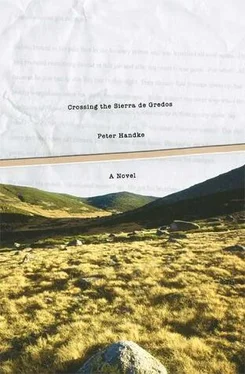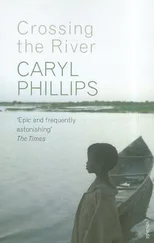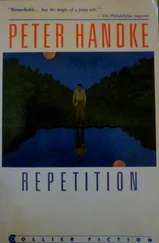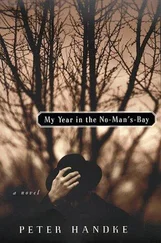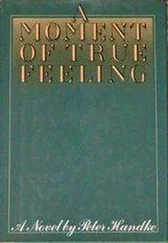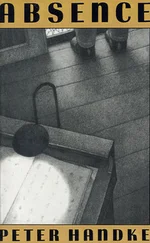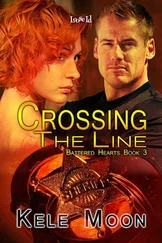Marvelous walking: beneath her feet the hoarfrost, still sole-deep, crunching and crackling as no snow could ever crunch and crackle (not only much quieter but also much farther away, or more dreamlike) — and overhead in the crowns a new pliability and a transformation from hoarfrost-white to trickling-water-black in the gentle thawing breeze. And in the bare chestnut trees the spiky fruit husks, long since split open, but now and then releasing a chestnut that had been held there for months by the husk, a lighter brown than those strewn over the forest floor, and not soft or rotting like them but firm and healthy, with fresh, pale-yellow flesh. What, edible chestnuts in January? Yes. She to the author: “What is time? I am still as puzzled by it as long ago in the village.” The magical emptiness of a Monday, the emptiness of the week’s onset in the forest.
But remarkable walking, too, because the forest had been destroyed a few weeks earlier by a December hurricane such as even this northwestern region, accustomed to powerful storms, had never experienced. The hurricane came in the night, and although it raged for hours, she slept on, slept and slept, more soundly than ever. As had happened quite often in her life, she missed the event. After that, going into the forest was prohibited. “But of course I went in.” The first time, the destruction looked to her far less extensive than what was shown in the newspapers and on television, and not only because around the small section depicted she could see the rest of the wooded area. But each time she returned, the destruction seemed more drastic. Did trees continue to hurtle to the ground after the storm was over? On the other hand, didn’t the long period of frost that followed the hurricane anchor the loosened roots in the soil? And yet each time there were more trees, limbs, crowns that had apparently fallen overnight. Or had her eyes merely shied away from taking them in all at once?
Not a wood-road that was not blocked by trees or scattered debris. One had to scramble over, or slip under, or take a tedious detour — which brought one smack up against the next obstacle, and then another, with the result that one might inadvertently end up outside the forest. So she decided in favor of scrambling and crawling. Decided? No, it went without saying that she would court obstacles and danger, as she always had. Danger? Some of the trees she dove under were not yet resting completely on the ground, but were still hung up on splintered limbs sticking in the earth, often only one support, and not a sturdy one.
But what was there to look at amid this devastation? There is no secret to devastation, she thought on her first sortie into the forest after the millennial storm. Only with repetition were her eyes opened. Where the trees had been uprooted, huge masses of soil had been heaved up. These were almost perfect half-spheres or else pyramids of sand, clay, and scree, cross sections tipped up perpendicularly, from whose midsection the lateral roots stuck out like rays, their ends sheared off and shredded, while the middle consisted of a much thicker fragment of root that projected toward the viewer, the mother root, so to speak. The trees torn out of the ground by the hurricane had thrust thousands of such former root balls up into the air.
The cleanup had not yet begun; it would require a ten-year plan, an entire army: but even if all the tree corpses were to be sawn up over the course of ten or twenty years and turned into neatly stacked woodpiles, it would be out of the question to level the densely scattered halved balls, pyramids, and earth cones that now reared up before one throughout the forest, like primeval yurts; all the layers of subsoil dragged out of the depths into the light with the roots, from the horizontal to the vertical, would probably remain this way forever.
That would create a new landscape, an area such as had never been seen before, with new, crazy-quilt horizons here, there, and everywhere. And because the wood of the roots was particularly durable, it would continue to portray the spokes of a wheel, with the hub in the middle becoming even more unmistakable later on, when sculpted by wind and weather. She had little curiosity, a trait she shared with most of the inhabitants of her native region: but she was curious to see how the transformed landscape would look.
And then the craters in all the places where trees had stood before the hurricane, most of them massive old oaks: now one could see, layer upon layer, the material deposited by previous millennia. The snail shells at the bottom of the craters had not rolled into them recently, but seemed to have been there from time immemorial. And similarly the oyster shells were not left over from a picnic in the woods, were not trash tossed into the root cavities after a tour of the damage, but were stuck there, removable only with hammer and chisel, as if baked, a thousand years earlier, to their prehistoric oyster bed, lifted by the catastrophe from what had once been the sea. And the black basalt there in the next soil layer down came from a vulcanic vein. Where am I? When did that take place? And was that now? And when is “now”?
None of the other trees had such spreading crowns as the giant oaks, or oak giants. At the same time, the branches in the crowns were interwoven, forming a dense mass. And nothing made a more powerful impression of devastation than all the oak crowns lying smashed on the forest floor. Yet even these almost countless heaps of broken limbs offered something to observe. On its way down, one of these giant trees had fallen on its equally large, equally broad, giant neighbor, which in turn had fallen on the oak in front of it, and now they lay there as a single trunk, forming a sort of transcontinental line, all pointing toward a common vanishing point at the very end of the continent.
This line was rhythmically punctuated by the ruined crowns, or crown ruins, which had the appearance, lying on the ground, of enormous cages, cages intended for games, for they were wide open in all directions, with remains of tangled branches. And never, in fact, had so many birds cavorted way up in the crowns while the trees were alive as did now down there amid the deadwood. Behind and between the bars of the pseudo-cages, birds eyed each other and whirred about, especially the smallest birds, the titmice, the sparrows, the robins, eating their fill of food that was otherwise out of range of their usual low flight orbit. They pecked and swallowed, and to the outsider seemed to be playing jailbird.
Now and then there were also fallen trees in parallel lines, and inside the parallel zones almost inaccessible patches of forest had formed, which, in the meantime, had begun to serve as new habitats (and not merely refuges) for a number of species that in recent years had almost disappeared from the forests, driven away or seemingly extinct: although they did not show themselves this morning, foxes had obviously recently dug themselves new lairs in these enclaves, and all the uprooted moss, scattered around in clumps, was their doing; wild hares openly darted back and forth between their holes, without fear, now returned to daylight after a period of keeping hidden (where?), and merely hidden, so not killed off; and squirrels now zigzagged horizontally through the protected area, as before up and down the trunks, while among them peacocks stalked majestically in purple and blue.
Only the flocks of wild pigeons had become homeless as a result of the shattering of the forest, and even now, weeks after the night of the hurricane, they kept fluttering (a great rattling from hundreds of pairs of wings) away from one of the few treetops still standing and described their usual one-quarter or one-half loop to the next treetop — but it was no longer there, so they were left treading the empty air like figures in an animated cartoon, before they circled on to the next tree of refuge — but it, too, was missing, and so on and so on, day in, day out.
Читать дальше
